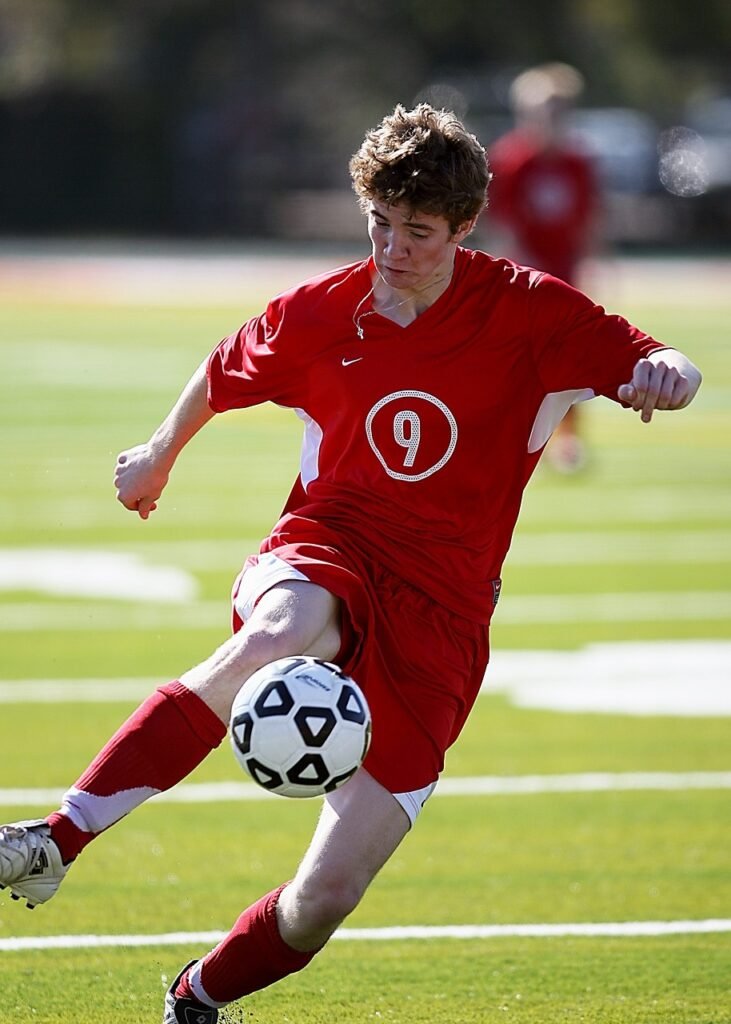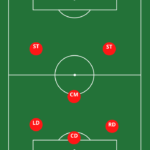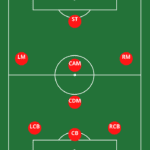- Last Updated -
The Changing Role of Strikers in Modern Soccer
Soccer, known as the beautiful game, has always had a place for the goal-scoring heroes upfront, commonly known as strikers. These players were once seen as mere finishers, waiting inside the penalty box to pounce on opportunities presented by their teammates. Join us as we investigate the Changing Role of Strikers in Soccer.
The traditional role of strikers revolved around putting the ball into the back of the net with ruthless efficiency. However, as soccer has evolved, so too has the role and responsibilities of these attacking maestros.
Brief Overview of Traditional Role:
In the early days of soccer, strikers were primarily expected to be lethal goal poachers. Their main objective was to position themselves in scoring positions within or near the penalty area and convert any chances that came their way.
These sharpshooters were celebrated for their ability to find space among defenders and deliver clinical finishes with precision and finesse. It was a simpler time when goalscoring was considered their sole purpose.
As soccer continued to evolve tactically and technically, so did the demands placed on strikers. The modern game now requires these attacking forces not only to score goals but also contribute significantly in other aspects of play.
Strikers are expected to possess a diverse skill set that includes creativity in creating scoring opportunities for their teammates. They must be able to read the game intelligently, finding passing lanes or making clever runs that unlock defenses.
Much like society itself, soccer has become a more complex entity with changing dynamics that demand versatility from its participants. The role of strikers is no exception; they are now required to adapt their game accordingly.

The Evolution of Strikers’ Responsibilities
From goal poachers to all-round attackers
In the early days of soccer, strikers were primarily seen as goal poachers. Their main objective was to position themselves in the box, waiting for crosses or through balls to put the ball into the back of the net. They were lethal finishers with a knack for finding scoring opportunities in crowded penalty areas.
However, as the game evolved, so did the role of strikers. Modern soccer demands more from its strikers than just goal-scoring prowess.
The emphasis has shifted towards strikers becoming all-round attackers who can contribute both with their goals and their ability to create scoring opportunities for their teammates. They are expected to be involved in the build-up play, combining with midfielders and wingers to unlock defenses.
Tactical flexibility and versatility
One significant aspect of this evolution is seen in the tactical flexibility and versatility that modern strikers bring to their teams. In recent years, we have witnessed the emergence of false nines – a tactical approach where a striker operates deeper on the pitch instead of staying solely within traditional positions in or around the box.
False nines have revolutionized positional play by creating confusion among defenders. By dropping deep into midfield areas or drifting wide, these strikers disrupt traditional defensive lines and create spaces for other attacking players to exploit.
This new approach has given birth to intricate passing movements and increased fluidity in team attacks. Strikers dropping deep to initiate attacks is another strategic shift we’ve witnessed over time.
Rather than waiting for service from midfielders, these modern attackers actively participate in building up plays from deeper positions on the field. By doing so, they become additional playmakers who can initiate attacks by providing accurate passes or making incisive runs behind opposition defenses.
This change reflects an understanding that modern soccer requires dynamic forwards who can influence the game beyond just scoring goals. Strikers need to be intelligent in their movement, adapt to different tactical systems, and possess a wide range of skills to thrive in contemporary football.
With the evolution of strikers’ responsibilities, the game has become more exciting and unpredictable. It’s no longer just about finding traditional goal poachers; teams now seek versatile attackers who can make significant contributions both inside and outside the box.
This strategic adaptation has added an extra layer of intrigue to soccer tactics, leaving defenders scrambling to adjust their lines and marking strategies. As soccer continues to evolve, one can only wonder what new roles and responsibilities will be assigned to strikers in the future.

Physical Attributes and Skill Sets Required
The Need for Speed, Agility, and Acceleration
When it comes to modern strikers, speed is no longer a mere luxury; it has become an essential attribute. With defenders becoming faster and more physically imposing, speed allows strikers to exploit defensive gaps quickly.
Whether it’s darting into open spaces between defenders or making those blistering runs in behind the opposition’s backline, pace can be a game-changer. A quick burst of acceleration can leave defenders trailing in the dust and create scoring opportunities out of nothing.
The Rise of Counter-Attacking Football
Counter-attacking football has become increasingly prevalent in the modern game, thanks to its effectiveness in catching opponents off guard. Strikers with exceptional speed are ideally suited for this style of play.
Their ability to rapidly transition from defense to attack allows teams to hit their opponents with devastating speed and precision. The counter-attack demands not only pace but also intelligent movement off the ball, as strikers must anticipate passes from teammates and exploit the gaps left by retreating defenders.
Technical Proficiency Beyond Finishing Ability
Dribbling Skills for One-on-One Situations with Defenders
In today’s soccer landscape, strikers are expected to do more than just put the ball into the back of the net; they need to be able to take on defenders individually as well. Dribbling skills are vital for navigating through tight spaces and beating opponents in one-on-one situations.
A striker who can dribble effectively becomes a nightmare for any defender who seeks to dispossess them or prevent them from getting a clear shot on goal.
Passing Accuracy and Vision for Link-Up Play with Midfielders
While traditional strikers were often seen as lone finishers waiting for service, the modern game demands greater involvement in the overall build-up play. Strikers now need to have excellent passing accuracy and vision to link up with midfielders and create scoring opportunities for their teammates.
The ability to pick out a precise through ball or execute a well-weighted pass can unlock stubborn defenses and showcase a striker’s versatility as both a scorer and creator.
The physical attributes required of modern strikers go beyond raw power or height. Speed, agility, and acceleration are crucial for exploiting defensive gaps quickly and thriving in counter-attacking scenarios.
Moreover, technical proficiency is no longer limited to finishing ability alone; today’s strikers must possess exceptional dribbling skills to navigate through tight spaces and an accurate passing range to contribute effectively to team play.
As the game evolves, so do the demands on strikers, requiring them to be more well-rounded athletes capable of impacting matches in numerous ways beyond simply scoring goals.

Tactical Adaptations by Teams
High-pressing and defensive responsibilities
Subtitle: A New Breed of Strikers Gone are the days when strikers were solely responsible for putting the ball in the back of the net.
In modern soccer, teams have employed a more proactive approach to disrupting their opponents’ play. This has led to a tactical adaptation known as high pressing, where strikers play a crucial role in applying intense pressure on the opposition’s defense.
One of the key defensive responsibilities that modern strikers have is to actively press opponents high up the pitch. By doing so, they aim to disrupt their opponents’ passing rhythm and force turnovers in dangerous areas.
This requires immense fitness levels and relentless work rate from these attackers. No longer are they simply waiting for opportunities in front of goal; they are now actively involved in winning possession back for their team.
Defensive contributions in pressing opponents high up the pitch
Subtitle: The Unseen Defensive Work While goalscoring prowess may be what garners attention, modern strikers also contribute significantly to their team’s defensive efforts through high pressing. Their primary objective is to apply pressure on opposing defenders right from the start of an attack.
Imagine this scenario: The opposition’s goalkeeper has possession of the ball, and your team pushes forward with intensity. As a striker, your task is not only to close down passing lanes but also make it difficult for defenders to find options under pressure.
By doing so, you create chaos and force mistakes that can be capitalized upon by your teammates. Strikers who excel at pressing effectively act as an invisible shield protecting their team’s defensive lines while affording precious seconds for midfielders or other attacking players to recover their positions and reorganize defensively.
Modern strikers as the first line of defense
Subtitle: From Attackers to Protectors In the past, strikers were primarily confined to offensive duties, but in the modern game, they have become the first line of defense for their team.
Coaches are now demanding more defensive contributions from their forwards, emphasizing the importance of winning back possession as quickly as possible.
With their position high up the pitch and close proximity to opponents’ defenders, strikers have a unique advantage in intercepting or pressuring the opposition’s build-up play. Their relentless work rate and positional awareness allow them to cut passing lanes and make crucial tackles or interceptions that disrupt opposing attacks before they gain momentum.
The evolution of modern soccer demands that strikers not only possess exceptional attacking prowess but also excel defensively. A well-rounded striker who can contribute effectively on both ends of the pitch has become an invaluable asset for any team aspiring to succeed in this highly competitive era.
The importance of positional intelligence
Subtitle: Mastering the Art of Timing Strikers with exceptional positional intelligence hold a significant advantage over their opponents. Understanding when and where to move off the ball is crucial in creating space for teammates and exploiting defensive weaknesses.
To be effective in creating chances or scoring goals, strikers must possess astute spatial awareness. They need to analyze game situations quickly, anticipate movements from teammates, and identify gaps within opposition defenses.
By constantly being on the move and making intelligent runs into channels or behind defenders, they open up possibilities for their teammates to find them with incisive passes. Moreover, understanding different attacking patterns based on team tactics is essential for strikers.
Whether it’s playing alongside wingers who like to cut inside or supporting overlapping full-backs on either side, adaptability is key. Strikers who grasp these nuances can seamlessly integrate into various systems while maximizing their impact on matches.
Modern soccer has witnessed a dramatic transformation in the role of strikers. No longer confined solely to finishing chances in front of goal, they now actively contribute to their team’s defensive efforts through high pressing and intelligent positional play.
Their ability to both create space for teammates and disrupt the opposition’s rhythm has become indispensable. For aspiring strikers, honing their defensive skills alongside their attacking prowess is essential in adapting to the ever-evolving demands of the beautiful game.

Specialized Roles within Striker Position
Target men: Holding up play and aerial dominance
Orchestrating Attacks with Height and Strength Within the realm of modern soccer, strikers have evolved to encompass specialized roles that cater to the diverse tactical demands of their respective teams. One such specialized role is that of the target man.
Standing tall with a commanding physical presence, these strikers utilize their height advantage and strength to hold up play and dominate aerial battles. In set-piece situations, they become vital assets, providing dangerous opportunities for their team to score.
Target men excel in redirecting long balls or crosses into goal-scoring positions, exploiting their ability to outmuscle defenders and outleap even the most agile opponents.
The importance of target men extends beyond scoring goals themselves; they act as fulcrums in attacking play by involving midfielders through their hold-up play skills.
By skillfully shielding the ball from defenders, they create time for teammates to make forward runs or find better positions to receive passes. Their ability to distribute the ball intelligently enables them to initiate attacks from deeper areas of the field, triggering intricate passing sequences that dismantle defensive structures.
Poachers: Opportunistic goal-scoring instincts
Subtitle: The Artistry of Being at the Right Place at the Right Time While some strikers thrive on orchestrating attacks and creating opportunities for others, others possess an innate knack for capitalizing on chances that come their way – these are known as poachers.
With predatory instincts honed over countless hours on training grounds and countless matches played, poachers possess an uncanny ability to find themselves in goal-scoring positions seemingly effortlessly. Poachers excel in reading plays before they unfold; they anticipate rebounds off goalkeepers or defenders and position themselves optimally within the box for tap-ins or close-range finishes.
Their sharp spatial awareness and split-second decision-making enable them to exploit the smallest gaps left by defenders, sneaking in undetected to convert half-chances into goals. A poacher’s value lies not only in their goal-scoring prowess but also in the psychological impact they impose on opposing teams.
Their reputation alone can force defenders into making mistakes, as the constant fear of a lurking poacher alters their decision-making process. This creates additional space for teammates, indirectly contributing to a team’s overall attacking threat.
Conclusion
Throughout the years, the role of strikers in soccer has undergone a remarkable transformation. From being mere goal-scoring specialists, modern strikers now possess an extensive skill set that includes not only finishing ability but also playmaking and defensive contributions.
Specialized roles such as target men and poachers highlight the diverse responsibilities bestowed upon strikers today. As the game continues to evolve tactically, we witness strikers adapting and excelling in these specialized roles with finesse and effectiveness.
Their height advantage allows target men to dominate aerial duels and create scoring opportunities for their teammates through hold-up play. Meanwhile, poachers demonstrate an extraordinary instinct for positioning themselves optimally within the box, capitalizing on even the slightest chances that come their way.
With each match played, strikers continue to redefine their positions on the field, pushing boundaries and challenging traditional notions of what it means to be a forward player.
As fans of this beautiful game, let us relish this evolution and celebrate these modern-day artists who grace us with moments of brilliance – whether through towering headers or predatory finishes – leaving us thrilled by their performances while forever changing our understanding of what it means to be a striker in modern soccer. (1)
The Historical Dominance of Brazilian Soccer in the World Cup
Introduction: The Beautiful Game's Grandest Stage The World Cup, a grand tournament...
Read More


















